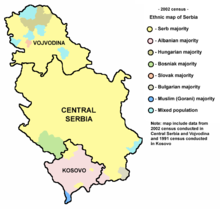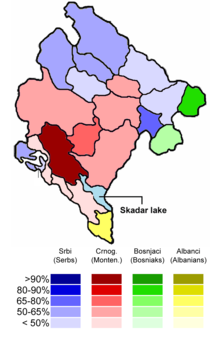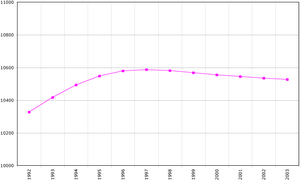- Demographics of Serbia and Montenegro
-
Population: 10,600,000 (Serbia - 9,981,929; Montenegro - 620,000)
note:Age structure:
0-14 years: Serbia - 19.95% (male 1,028,355; female 963,366); Montenegro - 22.05% (male 77,582; female 72,395)
15-64 years: Serbia - 65.22% (male 3,187,746; female 3,322,425); Montenegro - 66.16% (male 222,095; female 227,923)
65 years and over: Serbia - 14.83% (male 638,204; female 841,833); Montenegro - 11.79% (male 32,400; female 47,763) (2000 est.)Population growth rate: Serbia - 0.739%; Montenegro - -12.22% (2000 est.)
Birth rate: Serbia - 12.20 births/1,000 population; Montenegro - 14.9 births/1,000 population (2000 est.)
Death rate: Serbia - 11.08 deaths/1,000 population; Montenegro - 7.9 deaths/1,000 population (2000 est.)
Net migration rate: Serbia - 6.26 migrants/1,000 population; Montenegro - -29.18 migrant(s)/1,000 population (2000 est.)
Sex ratio:
at birth: Serbia - 1.08 male(s)/female; Montenegro - 1.09 male(s)/female
under 15 years: Serbia - 1.07 male(s)/female; Montenegro - 1.07 male(s)/female
15-64 years: Serbia - 0.96 male(s)/female; Montenegro - 0.97 male(s)/female
65 years and over: Serbia - 0.76 male(s)/female; Montenegro - 0.68 male(s)/female
total population: Serbia - 0.95 male(s)/female; Montenegro - 0.95 male(s)/female (2000 est.)Infant mortality rate: Serbia - 20.13 deaths/1,000 live births; Montenegro - 10.97 deaths/1,000 live births (2000 est.)
Life expectancy at birth:
total population: Serbia - 72.39 years; Montenegro - 75.46 years
male: Serbia - 69.31 years; Montenegro - 71.45 years
female: Serbia - 75.72 years; Montenegro - 79.82 years (2000 est.)Total fertility rate: Serbia - 1.70 children born/woman; Montenegro - 1.96 children born/woman (2000 est.)
Nationality:
noun: Serbian(s); Montenegrin(s)
adjective: Serbian; MontenegrinEthnic groups: Serb 62.6%, Albanian 16.5%, Montenegrin 5%, Yugoslav 3.4%, Hungarian 3.3%, other 9.2% (1991)
Religions: Eastern Orthodox 65%, Muslim 19%, Roman Catholic 4%, Protestant 1%, other 11%
- Roman Catholicism in Serbia and Montenegro
Languages: Serbian, Albanian, Croatian , Bosnian and Hungarian
Literacy:
definition: age 15 and over can read and write
total population: 96.4%
male: 98.9%
female: 94.1% (2002 est.)See also
- Demographics of Serbia
- Demographics of Montenegro
- Demographic history of Serbia
- Demographic history of Montenegro
Demographics of Europe Sovereign
states- Albania
- Andorra
- Armenia
- Austria
- Azerbaijan
- Belarus
- Belgium
- Bosnia and Herzegovina
- Bulgaria
- Croatia
- Cyprus
- Czech Republic
- Denmark
- Estonia
- Finland
- France
- Georgia
- Germany
- Greece
- Hungary
- Iceland
- Ireland
- Italy
- Kazakhstan
- Latvia
- Liechtenstein
- Lithuania
- Luxembourg
- Macedonia
- Malta
- Moldova
- Monaco
- Montenegro
- Netherlands
- Norway
- Poland
- Portugal
- Romania
- Russia
- San Marino
- Serbia
- Slovakia
- Slovenia
- Spain
- Sweden
- Switzerland
- Turkey
- Ukraine
- United Kingdom
- (England
- Northern Ireland
- Scotland
- Wales)
- Vatican City
States with limited
recognition- Abkhazia
- Kosovo
- Nagorno-Karabakh
- Northern Cyprus
- South Ossetia
- Transnistria
Dependencies
and other territories- Åland
- Faroe Islands
- Gibraltar
- Guernsey
- Jan Mayen
- Jersey
- Isle of Man
- Svalbard
Other entities - European Union
Categories:- Serbia and Montenegro
- Demographics by country
Wikimedia Foundation. 2010.



